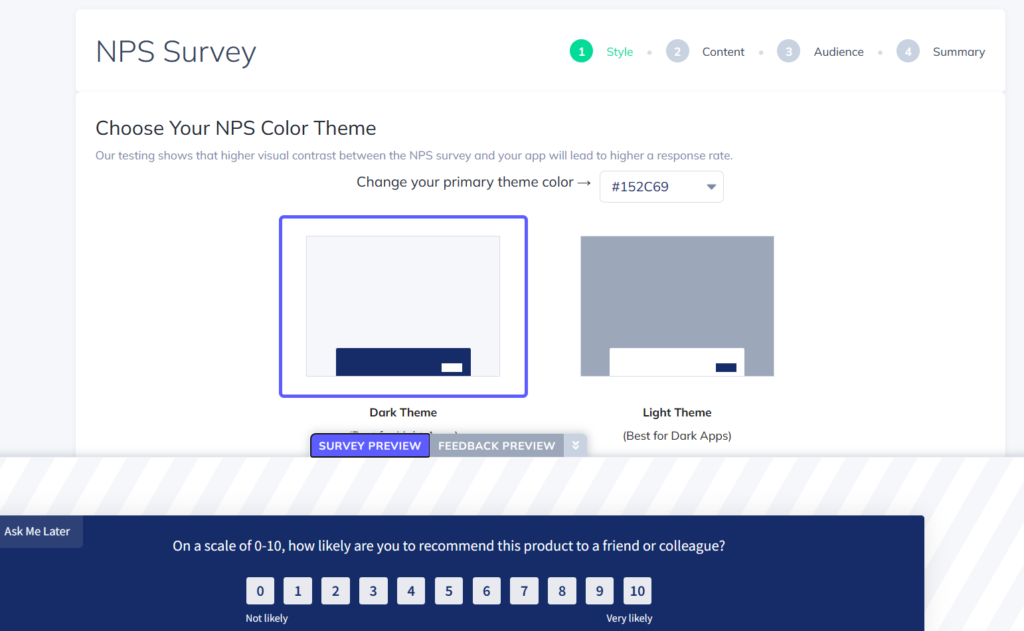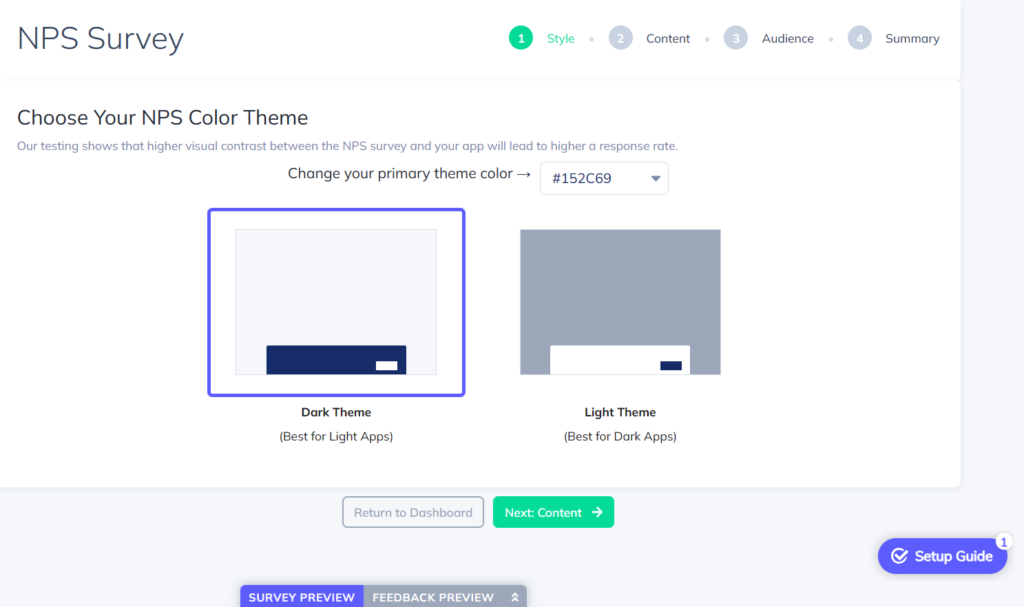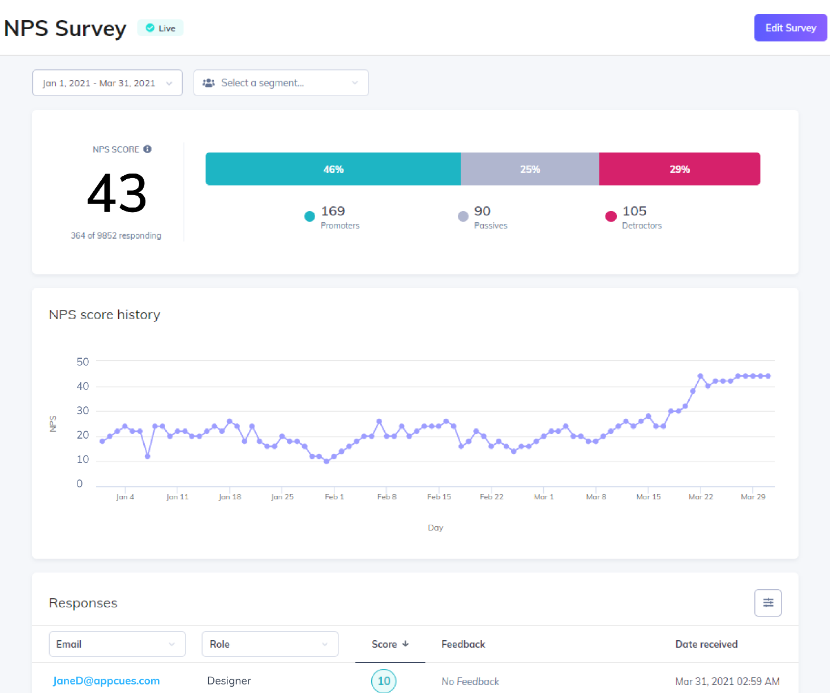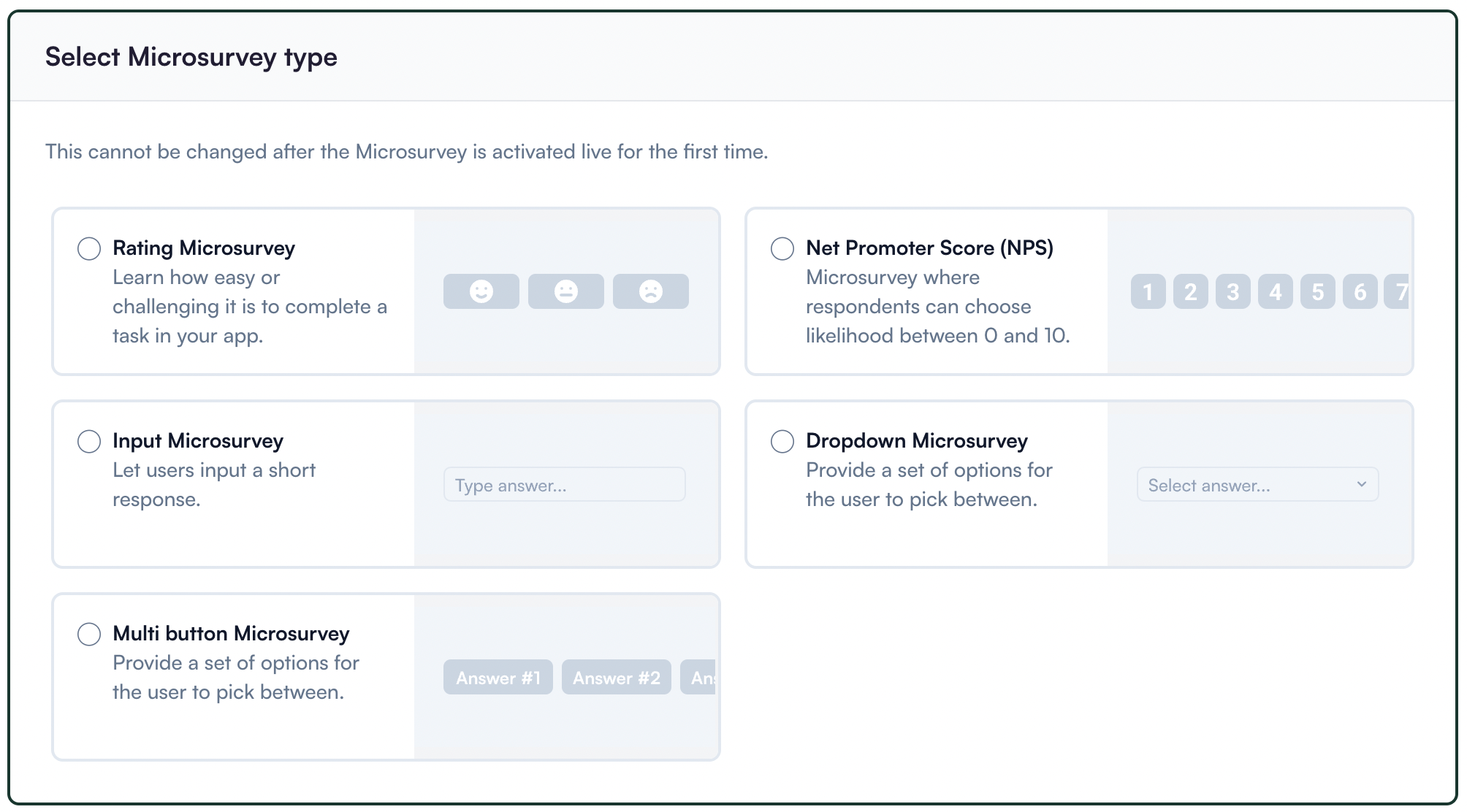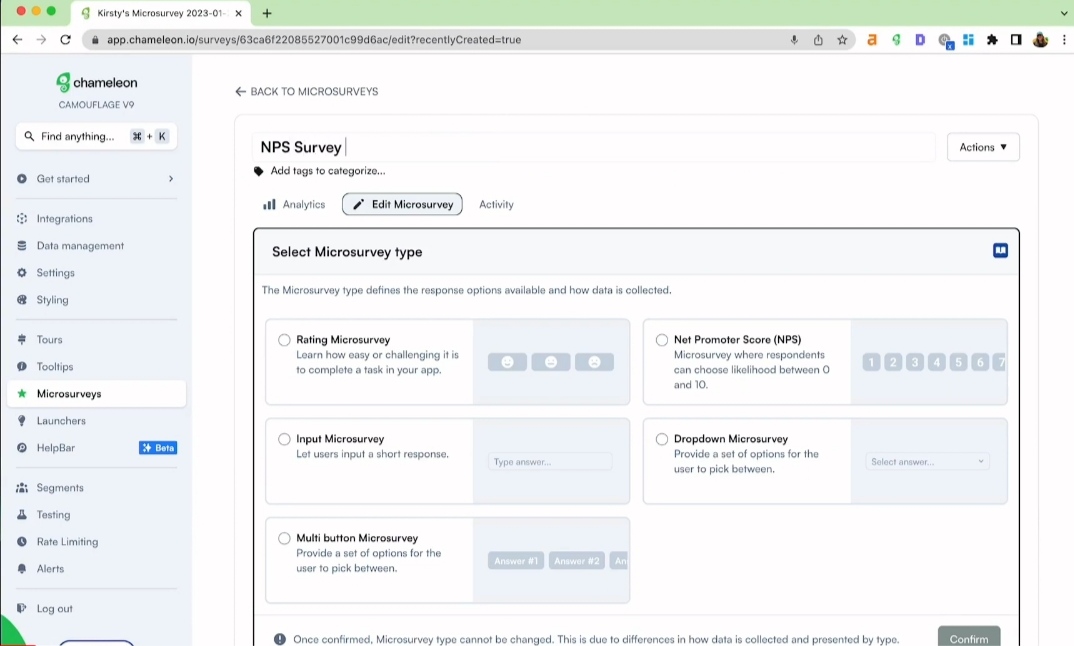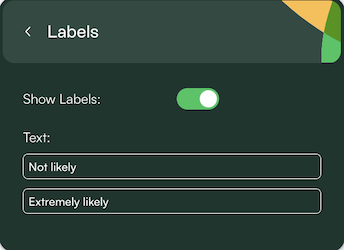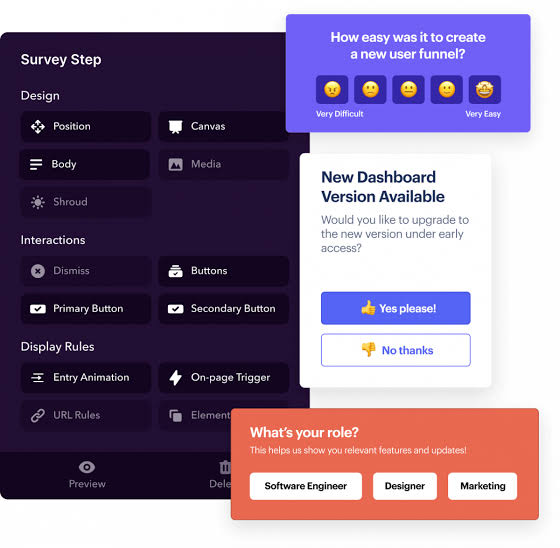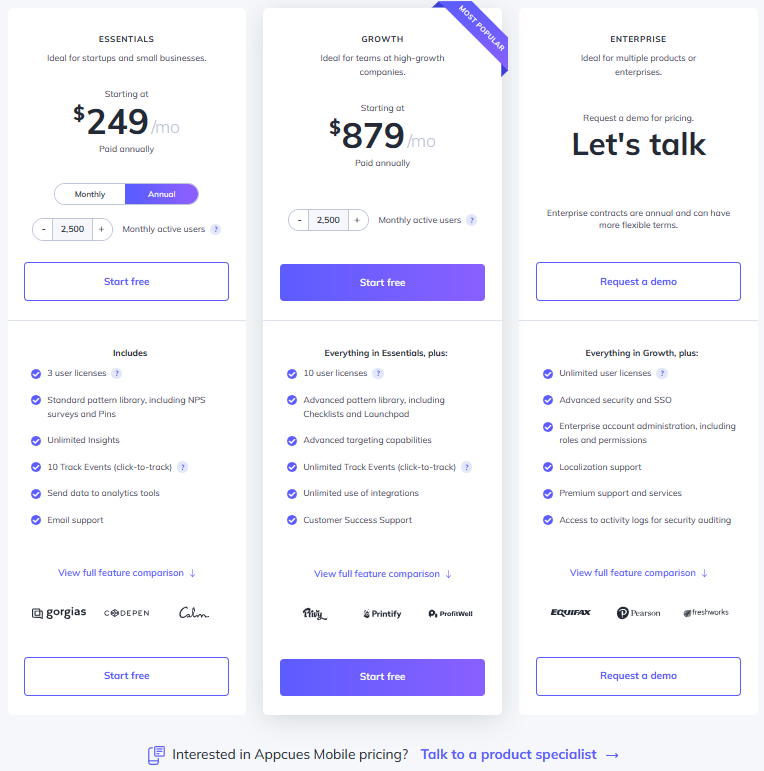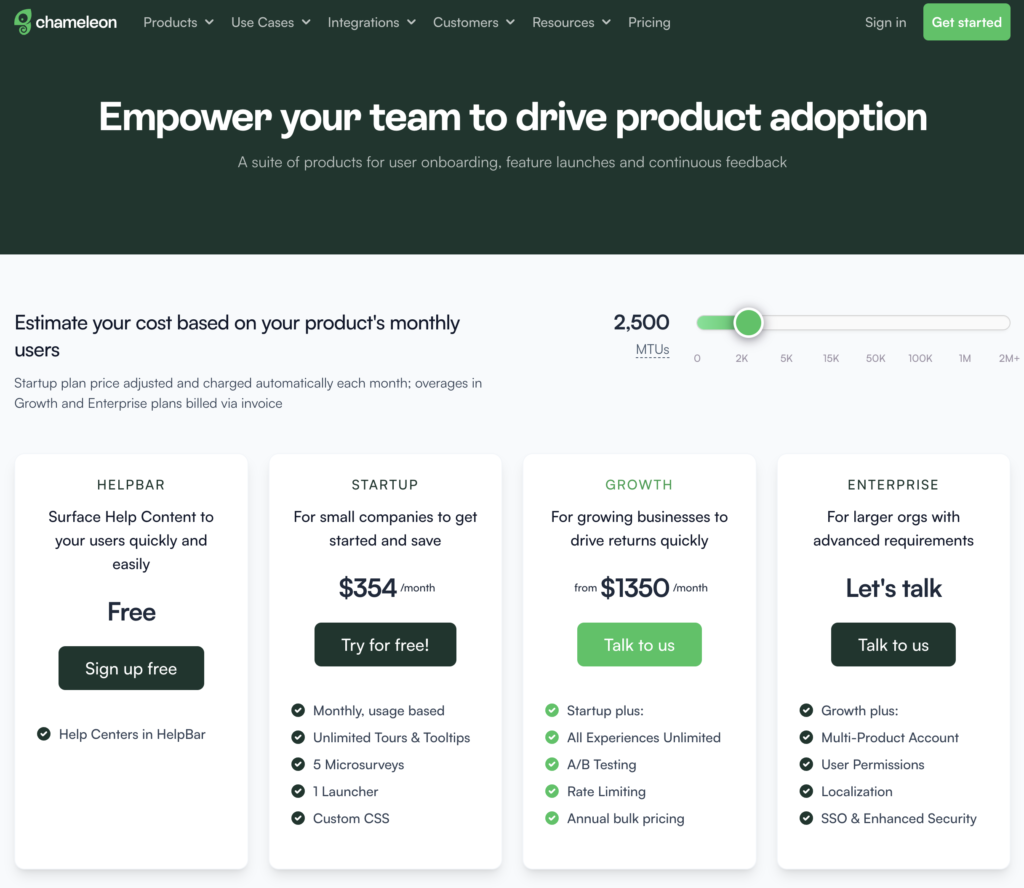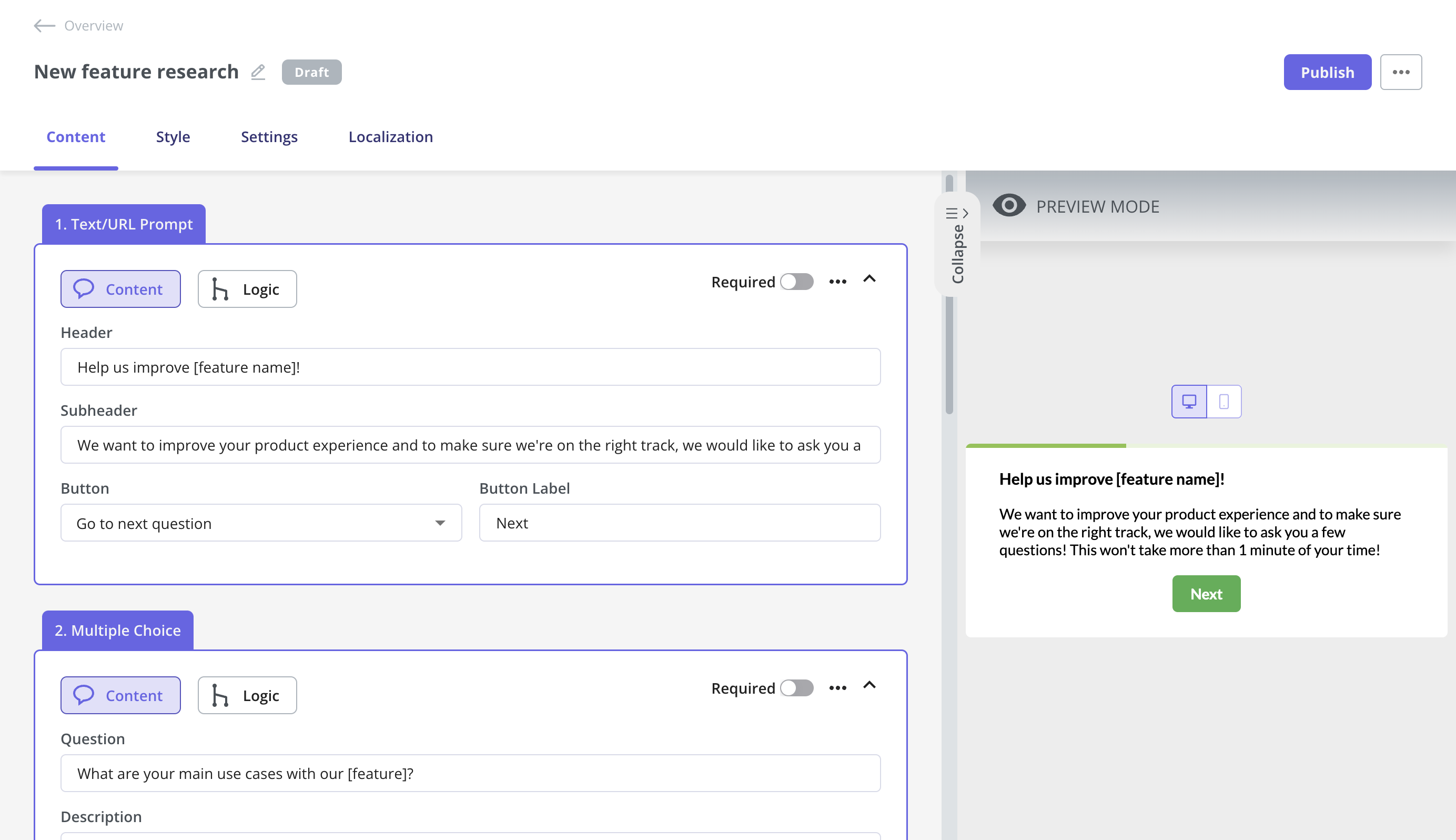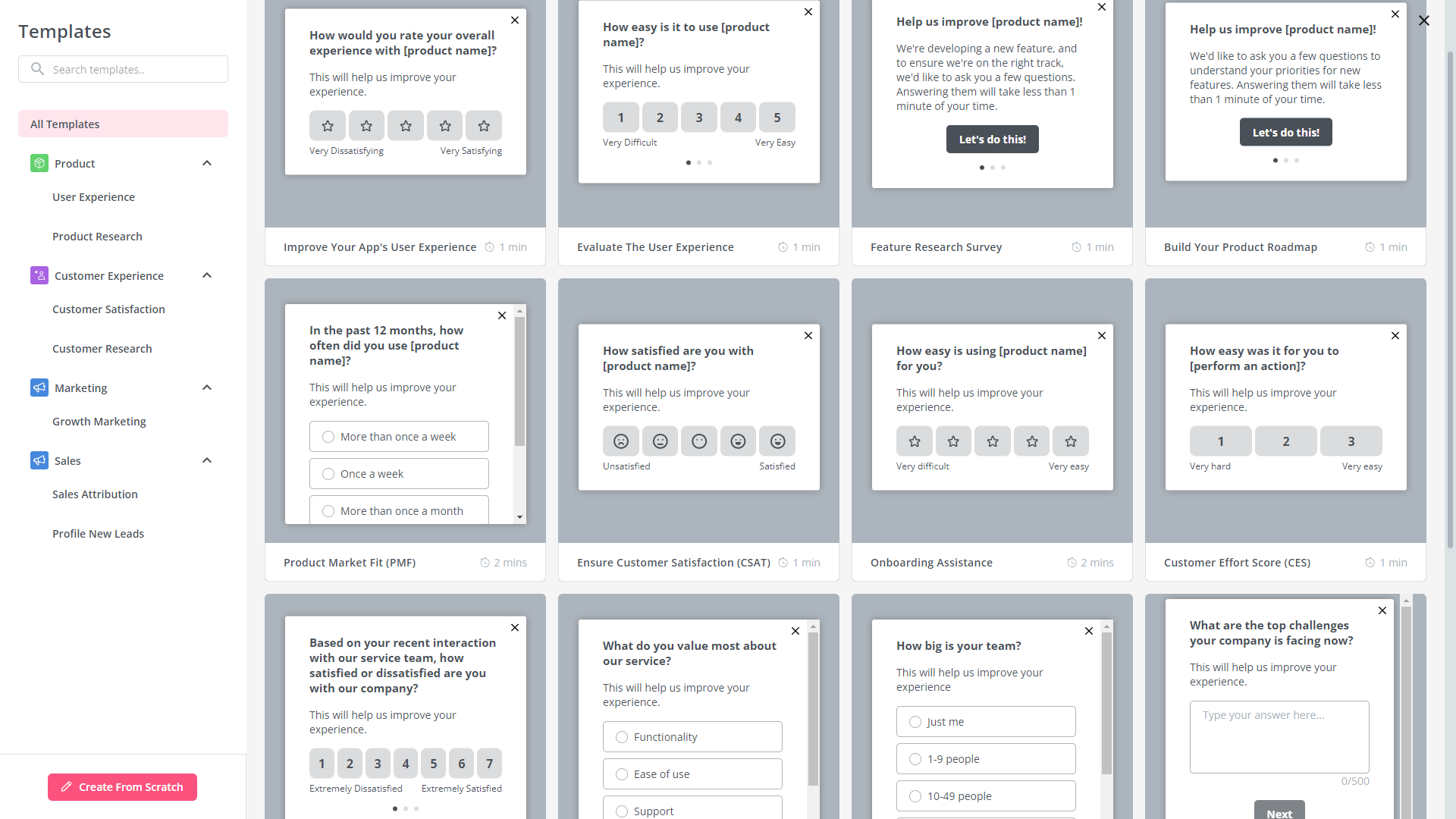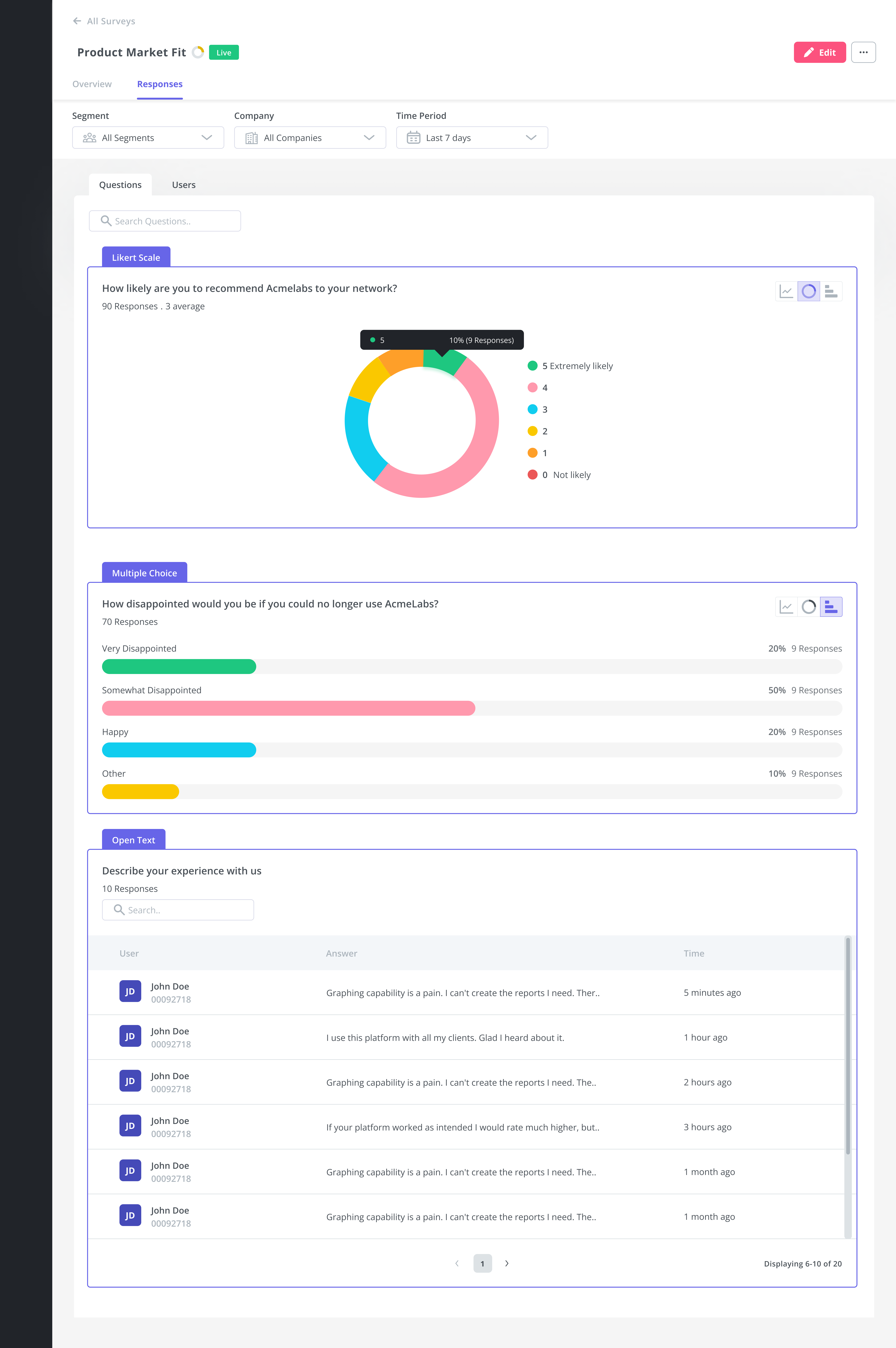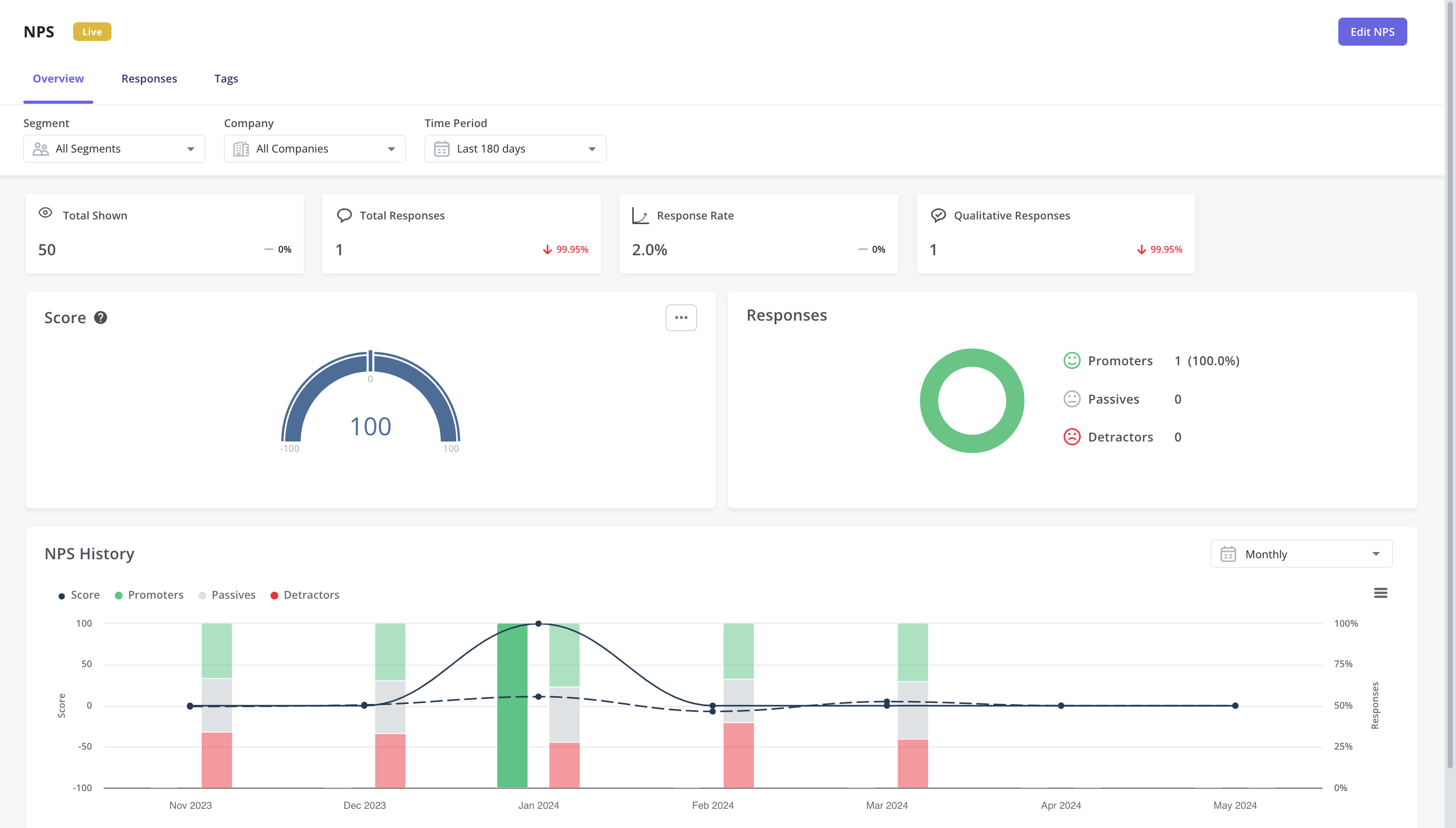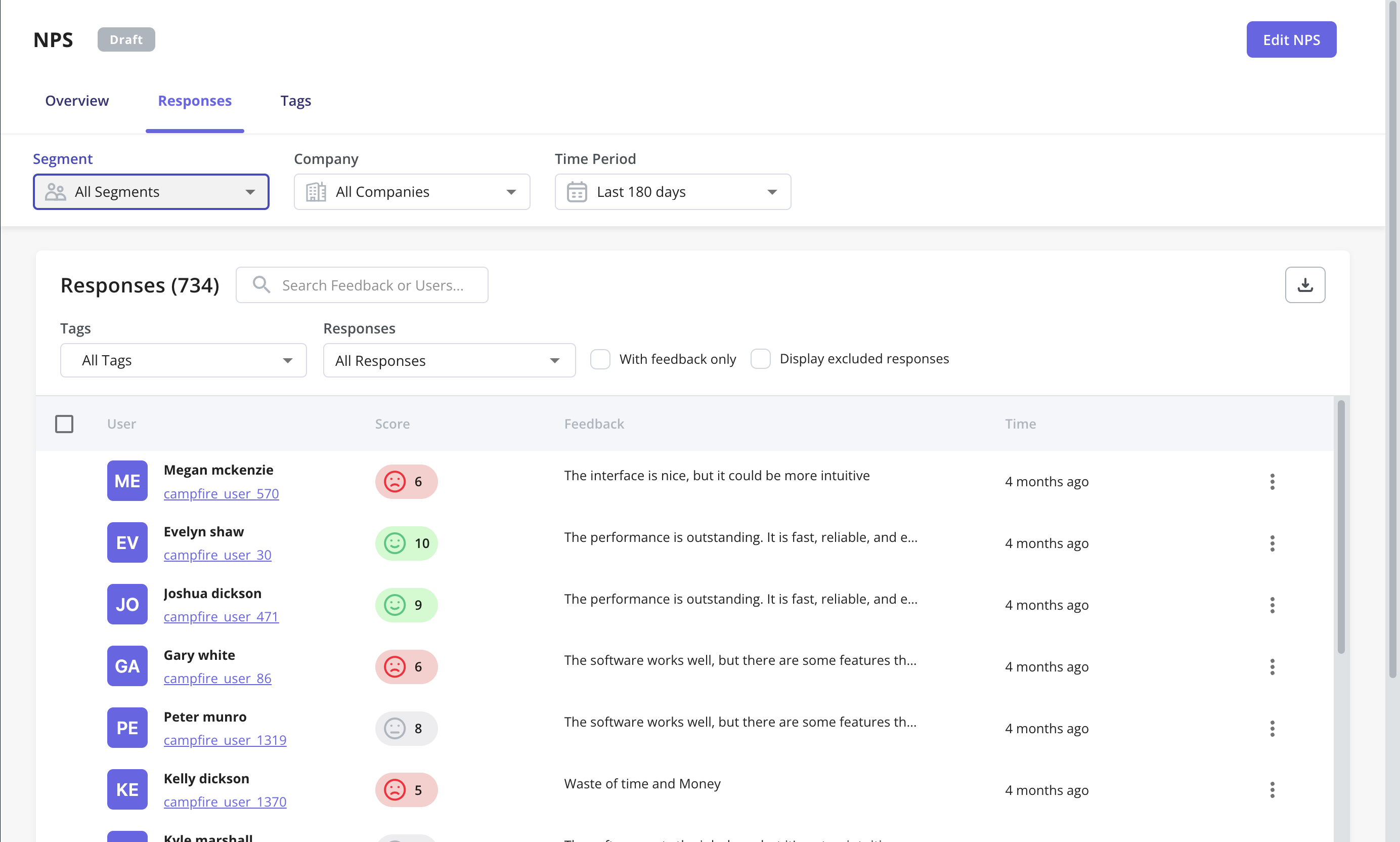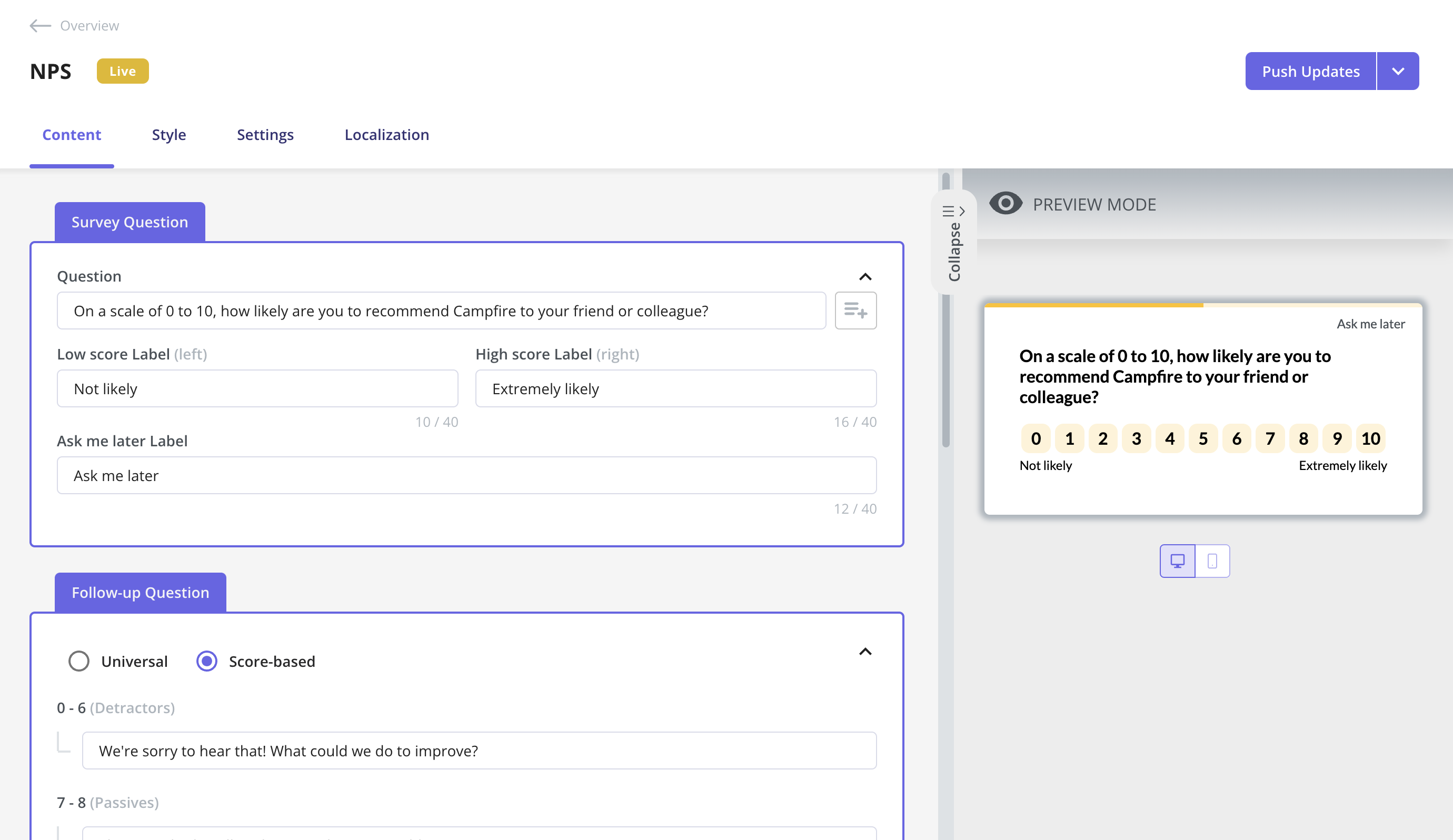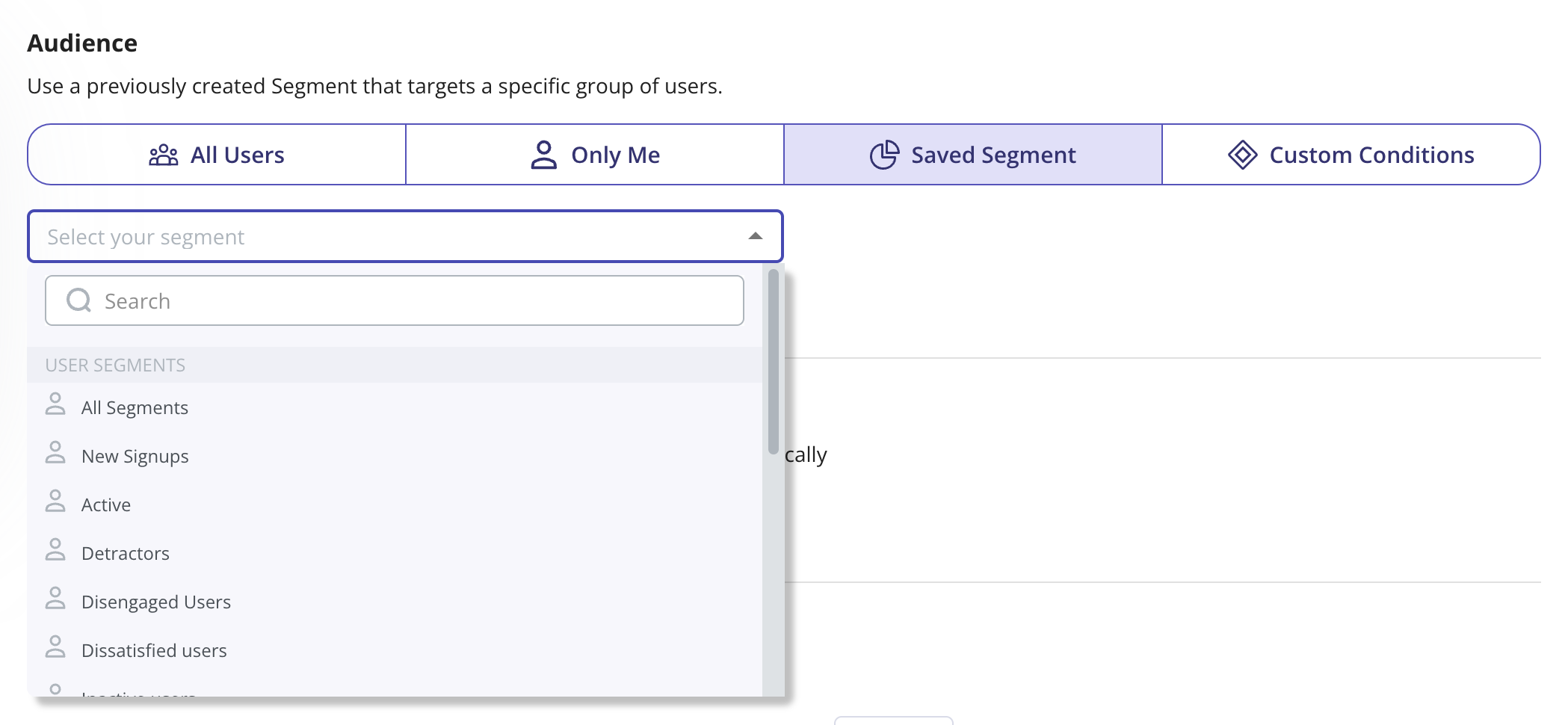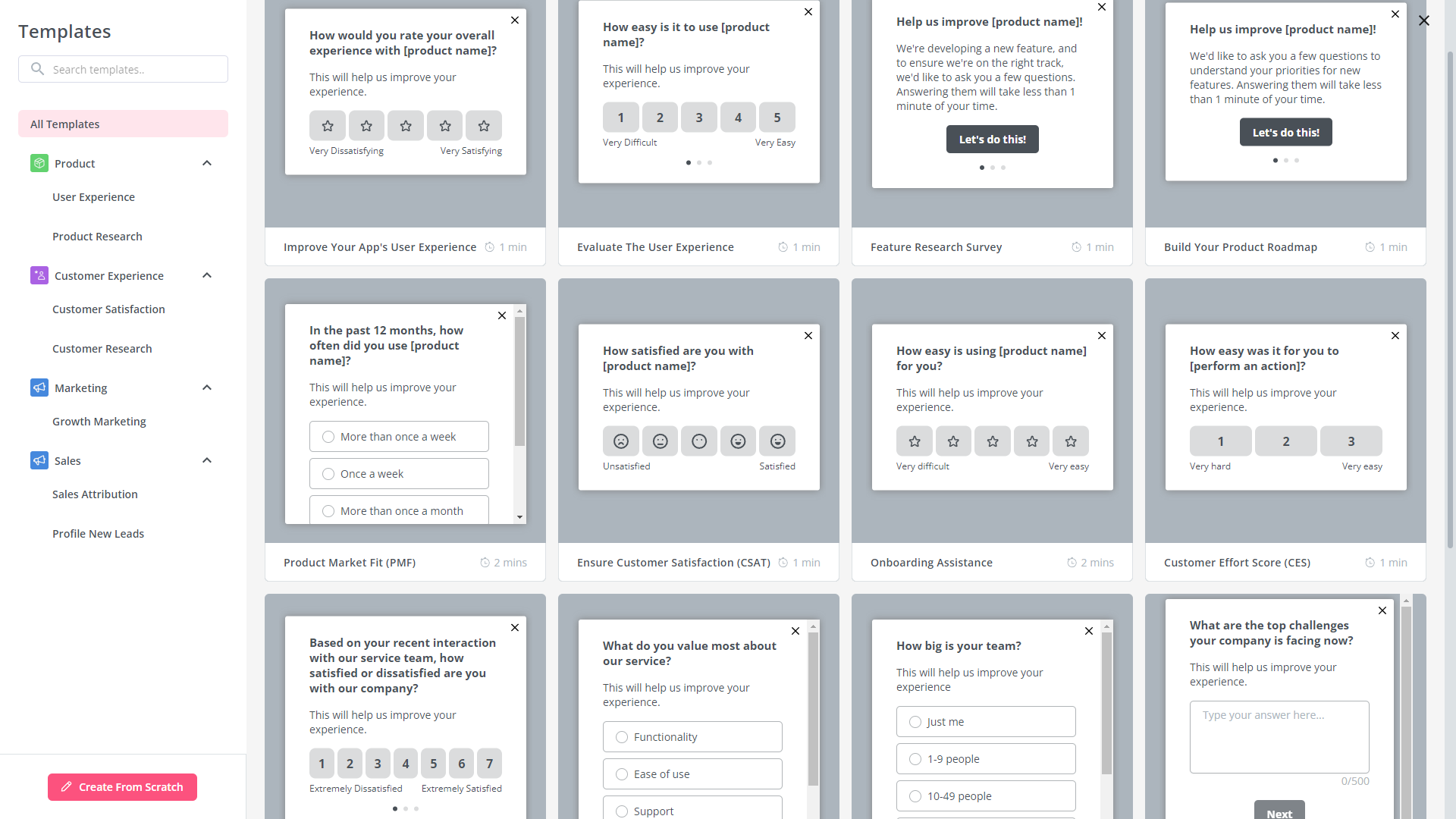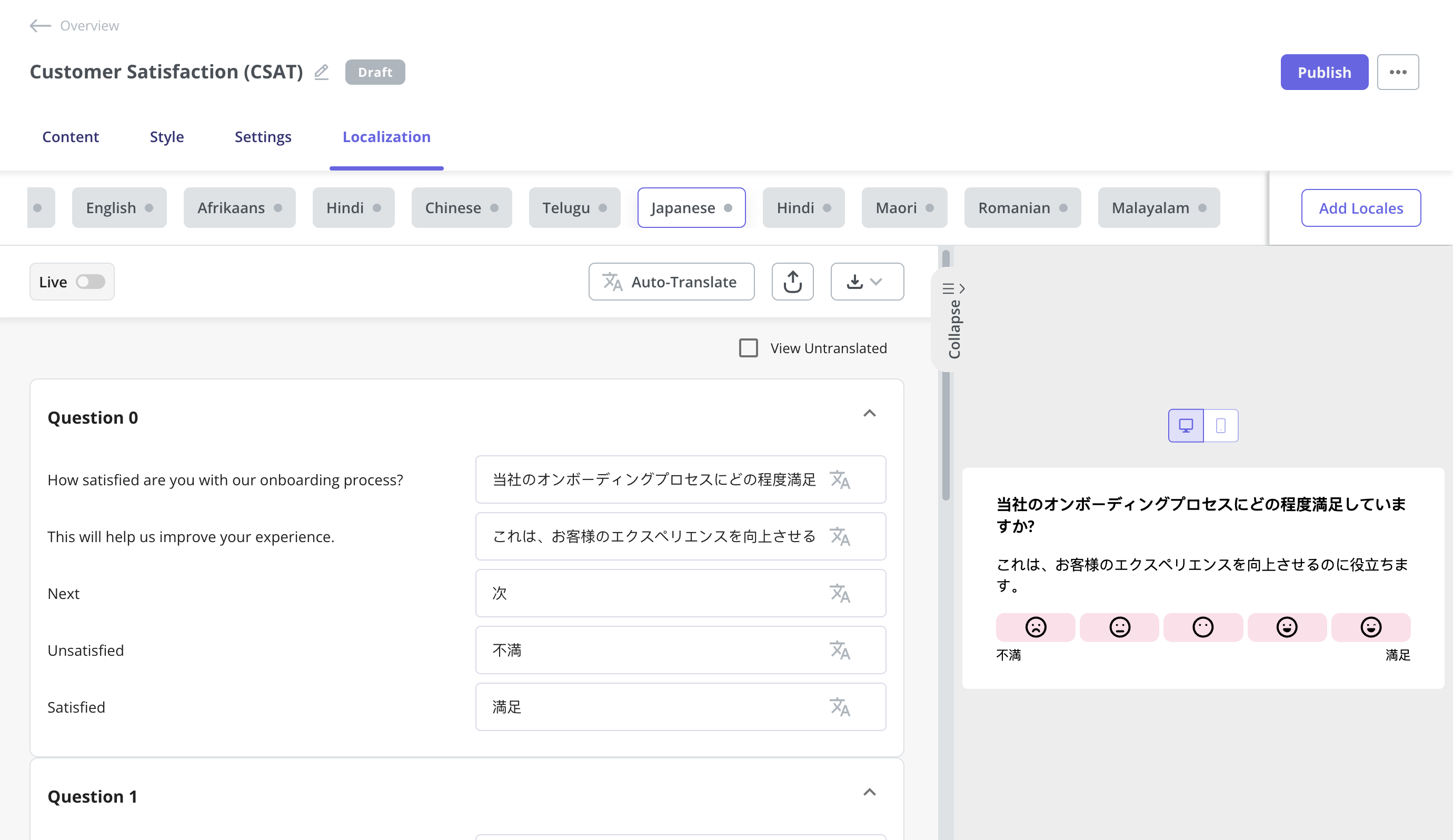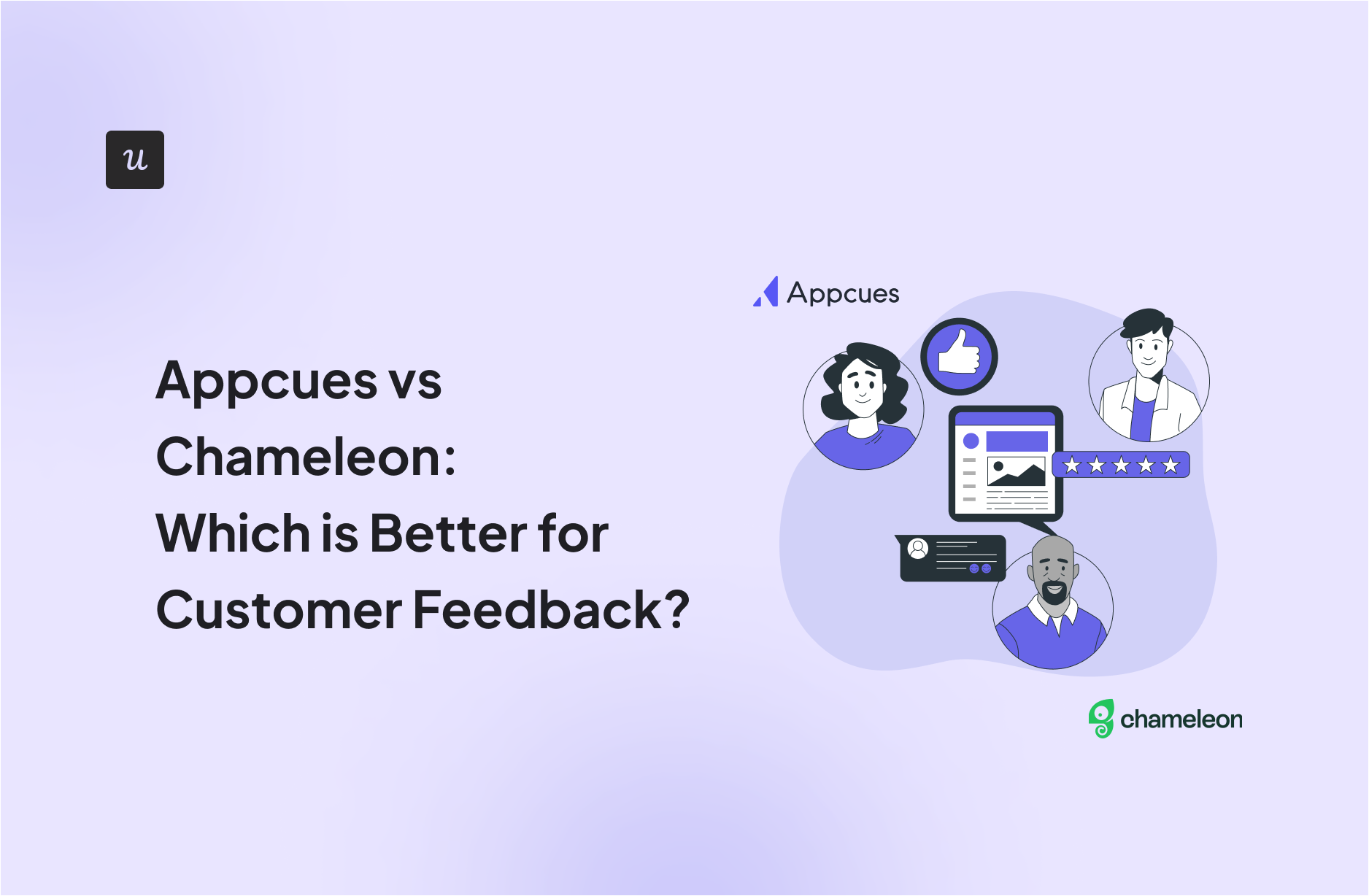
Try Userpilot Now
See Why 1,000+ Teams Choose Userpilot

Appcues vs Chameleon: Which one is a good choice for customer feedback?
- Let’s explore how Appcues and Chameleon compare when it comes to collecting customer feedback.
- Appcues is a robust product adoption and user onboarding platform for web and mobile apps. It enables product teams to create, implement, and test personalized in-app onboarding experiences. The platform also helps you announce new product features and collect customer feedback.
- Chameleon is a product adoption platform. It enables SaaS teams to leverage real-time user data to build beautiful on-brand experiences, improve user onboarding, and drive product-led growth.
- Considering functionalities and value for money, Userpilot is a better choice when it comes to collecting customer feedback. With features such as NPS surveys, in-app surveys, and survey analytics, it can help you with collecting and analyzing customer insights without coding.
- Get a Userpilot demo and drive your product growth code-free.
Must have features for customer feedback tools
On the lookout to find the best customer feedback tools? We’ve curated a list of the best tools that are trustworthy:
- Userpilot: best customer feedback tool for creating NPS surveys without Userpilot branding and with NPS tagging capability.
- Appcues: best customer feedback tool for creating mobile surveys.
- UserGuiding: best customer feedback tool for creating different types of microsurveys.
- Pendo: best customer feedback tool for feedback analytics.
- Chameleon: best customer feedback tool for contextual in-product feedback.
Let’s dive deeper into how each stacks up for different company sizes, budgets, and jobs to be done!
Appcues for customer feedback
As a product adoption platform, Appcues offers limited features that enable you to collect customer feedback. There is only one type of survey available (Net Promoter Score), and it comes with templates and analytics.
- NPS templates: You can customize pre-built NPS templates using the drag-and-drop builder.
- NPS targeting: Use NPS results to encourage promoters to review your product on app stores or ask detractors for more feedback.
- You could add a survey lookalike on top of a modal, but that means you won’t be collecting and analyzing results easily, defeating the purpose of using a survey for user feedback.
NPS surveys in Appcues
Appcues simplifies the process of creating and implementing in-app NPS surveys. You can set up the survey from Appcues Studio and customize it to match your brand image.
Besides no-code survey design, Appcues also lets you:
- Preview the survey before publishing it in real time.
- Access, analyze, and import in-depth survey results.
- Segment users based on survey results and target them with personalized messaging.
However, it’s worth noting that when it comes to breaking down NPS survey results, Appcues has a few limitations as it only gives you the score and answers. You can’t tag responses or do more in-depth analysis unless you download a CSV file with all answers and do a manual analysis.
Other platforms like Userpilot do a better job of breaking down responses by score, behavior patterns, and other parameters.
In-app surveys in Appcues
Appcues only lets you create NPS surveys to collect feedback from customers. You can use a workaround and add a microsurvey to a modal, but this won’t be collecting any analytics, and analysis responses will be difficult.
If NPS surveys are enough for you, here’s what Appcues offers:
- NPS: The most commonly used survey option is NPS, which lets you identify loyal users and detractors.
- Survey analytics: You can track, analyze, and visualize NPS survey results. It’s also possible to export the results into a PDF file.
- Target and trigger your NPS survey to specific audiences.
Chameleon for customer feedback
Here are some remarkable features of Chameleon for getting user feedback:
- Microsurveys: Create various microsurveys (up to 5 on the Startup plan), including NPS, CSAT, CES, Opt-in, and custom feedback types. You can customize your surveys but will need CSS knowledge for this, unlike other tools like Userpilot.
- Survey triggering options: Choose the survey frequency and repetition settings.
- Basic analytics: Access basic completion reports, while other data will be analyzed using integrated analytics tools from Chameleon. NPS scores will be visible in the reports, but additional analytics tools are required for other microsurveys.
It’s great that Chameleon lets you build beautiful microsurveys, but it might not be the best tool if you want to analyze the data and, most importantly, act on it. For example, with Userpilot you can create custom user segments based on survey responses or NPS scores and trigger specific in-app flows for them.
NPS surveys in Chameleon
What features make Chameleon an exciting tool for NPS surveys:
- Microsurvey builder: There are different types of microsurveys to enable more customized UX and analytics based on your use case. Net Promoter Score is a type of microsurvey. Within microsurveys, you can customize components such as question text, button text, button action (whether a button redirects users, opens a new tab, etc.), styling components, and entry animation.
- Labels: For each NPS microsurvey, you can easily adjust the labels from the Builder. Update the text or completely remove them by enabling the toggle. You can also personalize the Comments Steps based on whether a user was a: detractor (answered 0-6), passive (answered 7-8), or promoter (answered 9-10).
- Input settings feature for microsurveys: You can quickly modify the input field for the desired message type with each input microsurvey. You have a choice of the following under Input settings: brief text, lengthy text, Email Number, and URL.
While Chameleon offers a chunk of great features for customizing and styling NPS surveys, Userpilot is the best NPS survey tool because it allows you to build customizable NPS surveys and other user feedback surveys, collect unlimited responses, analyze data, segment users, and automate in-app responses based on the score the user gives you.
In-app surveys in Chameleon
With Chameleon, you can launch microsurveys based on user attributes such as plan type, role, or previous replies – then trigger the next actions based on user sentiment.
Below is a brief overview of the features Chameleon offers for in-app surveys:
- Integration with your favorite tools: Use tools like Typeform to launch in-app microsurveys and get user feedback.
- Filters feature: Filter your surveys based on completion rate, date created, date last edited, tags, and so on. This helps to segment your surveys based on the number of users and their interactions with the surveys.
- Trigger surveys based on users taking action: With this feature, you can easily direct your surveys to users who are consistent in taking action.
However, Chameleon lacks proper analytics to analyze your NPS or other survey responses over time. So if you want more in-depth analytics on your collected feedback, consider Userpilot.
Pros and cons of Appcues
Are you wondering if Appcues is the right fit for your user onboarding needs or if you should check out other options?
Here are a few reasons why using an Appcues alternative makes sense:
- You want more customizability. Customization options on Appcues are limited to color, size, and style. Advanced customization will require you to work with CSS code. It can be a roadblock when your team members lack technical expertise, leaving you dependent on developers.
- You’re on a budget. With Appcues, you’ll have to pay more to access advanced features like custom CSS, localization or even simple checklists. If you’re a startup or small business with a limited budget, you might benefit from using a tool like Userpilot that offers more value for money.
- You want to collect detailed customer feedback. Appcues offers limited functionality in terms of surveys. If you want to explore other survey and feedback collection formats apart from NPS, Appcues may not be an ideal choice.
Pros of Appcues
As a first-comer in the no-code product adoption landscape, Appcues offers several valuable features. It’s suitable for mid-market SaaS businesses looking for a simple, easy-to-use tool that enhances user onboarding, retention, and the overall customer experience.
Let’s take a closer look at the benefits of Appcues:
- Intuitive UI and UX: Appcues offers a straightforward interface that’s easy to navigate and use. Users with non-technical backgrounds can design captivating in-app flows and onboarding journeys with its simple drag-and-drop builder. You can tailor user journeys with various UI patterns, from modals and hotspots to tooltips, slideouts, and banners.
- Simple setup: You can get started with Appcues in minutes by adding the SDK to your app’s source code or integrating Appcues with Segment or Google Tag Manager. Then, add a Chrome extension to launch the Appcues Builder in a few quick clicks and start creating in-app flows.
- Feedback options: Create Net Promoter Score (NPS) surveys to collect actionable user feedback. You can even check and analyze NPS analytics on your Appcues dashboard.
- Mobile onboarding: Besides web apps, you can use Appcues to create end-to-end experiences for mobile apps. It supports various mobile environments, including Native Android, Native iOS, React Native, Flutter, and Iconic.
- Extensive integrations: Appcues integrates with 20+ email automation, CRM, and analytics tools, including Heap, Zapier, HubSpot, Google Analytics, and Google Tag Manager. Many of these include two-way integrations.
Cons of Appcues
Appcues comes with a ton of useful features you’d expect from a leading product adoption platform, but it does have a few shortcomings.
Let’s look at a few drawbacks of Appcues:
- Poor element detection: The Appcues algorithm occasionally struggles to detect in-app elements, unlike some of its competitors like Userpilot. It’s particularly limiting when you want to add tooltips to individual options in a dropdown menu.
- Limited customization capabilities: While Appcues lets you customize pre-designed templates, you’re limited to basic options like font style, size, color, and padding. Advanced customization requires working with CSS code, which can be challenging for non-technical teams.
- Basic analytics: Appcues provides insights into product usage and customer behavior. However, you can’t access in-depth analytics without connecting to a third-party tool like Amplitude or Google Analytics.
- Limited survey options: Appcues lacks variety in feedback collection and survey options and doesn’t offer integrations with other platforms like Google Forms and Typeform. You can only build NPS surveys. This is in contrast to some of its competitors, like Userpilot, which offers an extensive library of customizable survey templates.
- Higher pricing: Starting at $249 per month, the Appcues Essential tier has several constraints, such as limited UI patterns and no custom CSS support. Moreover, localization support is only available in the Enterprise tier. If your app is multilingual, you’ll have to shell out a ton of money to make the most of Appcues.
- No live chat: While Appcues offers educational resources and a help center (Help Docs), customer support is limited to email and phone.
Pros and cons of Chameleon
Despite its strong performance when it comes to creating personalized and highly customized user experiences, Chameleon is not the most competitive tool when compared to similar products.
Here are three reasons why you might need to look elsewhere:
- You are on a budget: To get access to all the needed tools for proper onboarding and adoption, you need to pay for the higher plans that can get expensive.
- Requires CSS knowledge: Custom CSS works by targeting specific elements of Chameleon Experiences to change their styling. However not all users have an idea what CSS is all about, so, you need to be technically savvy.
- Analytics are not advanced: Chameleon doesn’t possess robust analytics features like Userpilot does. You might want to consider another tool if you need accurate product and user analytics, without paying for additional tools.
Pros of Chameleon
From a wide array of features to aesthetic UI patterns that can create any flow no matter how customized they need to be, Chameleon is no doubt a powerful tool for scaling product adoption.
It works in a similar way to Userpilot and offers similar features: styling, analytics, templates, goals, A/B testing, and checklists.
Let’s look at the pros of using Chameleon:
- Intuitive no-code builder: Chameleon comes with an easy-to-use Chrome Extension builder.
- Engaging tour guides: Build interactive tours to onboard users, announce features, and create other customer in-product experiences using simple steps.
- Good range of in-app messaging and UI patterns: Easy to create custom modals, slide-outs, tooltips, hotspots, launchers (checklists or resource hub), and more.
- Full two-way and deep analytics integrations: Chameleon fits into your stack and easily connects with your favorite tools to send data to and from Chameleon. It offers the deepest integrations with analytics tools, CRMs, and more.
- Effective segmentation and targeting system: Leverage user data and experiences to structure effective marketing messages and tour guides for a specific target audience.
- Advanced A/B testing: Drive continuous improvement of in-app messages and define the ideal user experience with precise A/B testing.
- Rate limiting: No user wants to be overwhelmed with multiple product tours, in-app messages, and tasks. With rate limiting, you can reduce the number of user experiences — one step at a time, with clarity over speed.
Cons of Chameleon
While Chameleon is a deep production adoption tool with an array of great features, there are still some downsides. Here are the main cons of the tool:
- Not entirely no-code: Early on, we stated that Chameleon can be used without code. True. But it is not a completely no-code tool. You’ll need the help of a technical-savvy employee in your team to sort out some build-up as the learning curve is steeper.
- Hard-to-use interface: The new UI is a bit harder to use (a lot of clicking), and there can be minor bugs here and there.
- Limited experiences: There are some limitations to the user onboarding flows. For instance, you can’t run multiple in-app experiences at the same time, as you can in Userpilot.
- Pricey: The Startup plan is quite expensive (starts at $349/mo for 2500 MAU and includes just one launcher). This means you need to go for the Growth plan, where you pay more but save more at the same time.
Appcues vs Chameleon: Which one fits your budget?
Understanding the cost implications is paramount when selecting the right solution for customer feedback, so here’s a detailed pricing comparison of Appcues and Chameleon.
Pricing of Appcues
Pricing for Appcues starts at $249 per month, with the platform offering three distinct tiers – Essentials, Growth, and Enterprise.
The total cost can vary depending on the number of monthly active users (MAU). For instance, the Essential plan starts at $249 per month for 2500 MAU but jumps to $299 for 5000 MAU.
Here’s a detailed glimpse of the different pricing tiers:
- Essentials: It’s the basic tier that starts at $249 per month. It includes 3 user licenses and lets you add up to 5 audience segments. Some UI patterns, such as checklists, launchpads, and custom CSS support, aren’t available. Customer support is only available through email.
- Growth: This tier starts at $879 per month (for 2500 monthly active users) and includes 10 user licenses. You can target unlimited audience segments and use the full spectrum of UI patterns. Additionally, you can access the Premium Integrations package, which includes integrations with Slack, Salesforce, Marketo, and Zendesk.
- Enterprise: This is the most feature-packed tier and includes robust security controls like role-based access and activity logs. It’s also the only tier that comes with multi-account and localization support. Besides email and phone support, you also get a dedicated Customer Success Manager and Technical Implementation Manager. Pricing is available on request.
All three plans come with a 14-day free trial, where you can test unlimited flows and track up to 5 events. You can extend the trial by another 14 days by installing the Appcues SDK in your app. Additionally, you don’t need a credit card to sign up for the free trial.
Keep in mind that the above pricing plans are applicable to web apps. Pricing for Appcues Mobile is available on request.
It’s also worth noting that Appcues is pricier than some of the other product adoption tools available in the market, including Userpilot. For instance, Userpilot’s basic tier (Starter) lets you add up to 10 audience segments and includes the complete set of UI patterns.
Pricing of Chameleon
Chameleon’s pricing is based on your product’s monthly users. From the Startup plan (for small companies to get started and save) to the Growth and Enterprise plans (for larger organizations with advanced requirements) billed via invoice.
Here’s an overview of the pricing plans and features of each plan:
- Help Bar: This is a standalone search function on top of your product, allowing users to search your knowledge base articles.
- Startup plan: For small companies to get started. Fee: $354/month, billed Monthly, usage-based, Unlimited Tours and tooltips, 5 microsurveys, 1 Launcher, Custom CSS.
- Growth plan: For growing businesses to drive returns quickly, from $1350/month. Everything in the startup plan, plus: unlimited microsurveys & launchers, A/B testing, and rate limiting is paid annually with bulk pricing.
- Enterprise plan: For larger organizations with advanced requirements. The fee for this plan is not stated on the website rather, you get to talk to the team. You get everything in the growth plan, multi-product account, user permissions, localizations, and SSO/enhanced security.
The Growth plan seems to be the real deal because of the exciting features that can boost your product marketing. For example, you can’t get the rate limiting feature on the Startup plan, including A/B testing. These are relevant and powerful product adoption weapons that should be in your arsenal if you truly want to win more users.
Is the startup plan expensive?
Yes, compared to Userpilot, about a $170 difference. It’s best to opt in for the Growth plan for the juicy benefits, where you pay $1350 annually rather than paying a whopping $5000+ yearly for the startup plan.
Userpilot – A better alternative for customer feedback
User feedback is an essential part of listening to the Voice of the Customer (VoC) and making product development or marketing decisions that best suit your customer base. Userpilot has a no-code survey builder, 14 templates to choose from, and advanced analytics for extracting insights.
Here are the Userpilot features you can use to collect customer feedback and analyze it:
- Survey builder: Userpilot’s survey builder lets you edit the content, update the widget’s style/placement, and set page-specific or event-specific triggers to ensure that users see the survey at the most contextual moment — all without writing a single line of code. You can also translate surveys into your audience’s native language.
- Survey templates: There are 14 survey templates to choose from with a wide array of different use cases. You can collect qualitative responses on how to improve the user/product experience or quantitative data for customer satisfaction benchmarking, such as CSAT and CES scores.
- Advanced analytics: Userpilot’s advanced survey analytics will show you what the most common responses were, what percentage of users selected a specific option, and display open-ended feedback about your product or specific features.
Survey analysis in Userpilot. - NPS dashboard: Userpilot’s NPS dashboard compiles response data from all NPS surveys, so you don’t have to manually go into each survey and check its analytics. You’ll be able to view key metrics like response rates, total views, and NPS history and sort all the data by different segments.
NPS dashboard in Userpilot. - NPS response tags: Userpilot comes with NPS response tags that you can use to categorize qualitative NPS answers for analyzing purposes. You can use these tags to identify common issues among passives and detractors or find satisfaction drivers among promoters.
NPS response tags.
NPS surveys in Userpilot
The Net Promoter Score (NPS) is a reliable measure of how satisfied customers are and how likely they are to recommend your product to others. Userpilot lets you build NPS surveys, analyze response data, and target specific user groups to gather actionable insights.
Here are the Userpilot features you can use when sending NPS surveys:
- No-code builder: The survey builder lets you edit the content of your NPS surveys, style the widget to your liking, restrict surveys to specific pages/paths, and use AI-powered localization to change the language of your survey.
- Audience targeting: Userpilot’s audience targeting features let you choose which users to include in NPS surveys. You could set this to all users, select only me if you’re still in the testing stage, target a particular segment, or set conditions that must be met for a survey to appear.
Userpilot offers multiple options for delivering your NPS surveys to users. - Analytics dashboard: Userpilot’s dedicated NPS dashboard shows you all the key data gathered from your surveys. These include how many views your NPS surveys have gotten, the number of responses, the overall response rate, and how the score has been trending over time.
NPS dashboard in Userpilot. - NPS response tags: Userpilot comes with NPS response tags that you can use to categorize qualitative NPS answers for analyzing purposes. You can use these tags to identify common issues among passives and detractors or find satisfaction drivers among promoters.
In-app surveys in Userpilot
In-app surveys are an effective way to collect direct feedback from users without being at the whim of their email inboxes. Userpilot’s built-in functionality lets you create surveys, translate them, and track granular survey analytics that offer additional user insights.
Here are the Userpilot features you can use when building in-app surveys:
- Survey templates: Userpilot’s no-code survey builder has 14 templates to choose from. These include NPS, CSAT, and CES surveys among others for collecting quantitative and qualitative feedback from users. You can add a series of questions to gather valuable insights.
- Survey translation: Userpilot’s AI localization feature lets you translate surveys in a matter of minutes. All you need to do is add the desired locale and leave the rest to Userpilot. You can also make manual tweaks to translations if needed.
- Advanced analytics: Userpilot has detailed analytics that shows what percentage of users chose a specific option, summarizes the most popular choices, and lets you browse through open-ended responses to extract insights from qualitative feedback.
Survey analysis in Userpilot.
Pricing of Userpilot
Userpilot offers flexible pricing based on your monthly active users (MAUs). Plans start at $299 per month for smaller teams and scale as your user base grows.
Userpilot has three pricing plans you can choose from:
- The Starter plan begins at $299/month (billed annually) for up to 2,000 monthly active users. It includes in-app user engagement, usage trend analysis, NPS surveys, and essential product analytics—ideal for mid-market SaaS teams getting started.
- The Growth plan offers custom pricing and adds advanced analytics, retroactive event auto-capture, in-app surveys, session replay, and more. It’s the most popular choice for growing teams that need deeper insights and scale.
- The Enterprise plan offers custom pricing and includes everything in Growth, plus bulk data handling, custom roles and permissions, SOC 2 Type 2 compliance, and enterprise-level support.

What do users say about Userpilot?
Most users laud Userpilot for its versatile feature set, ease of use, and responsive support team:
I recently had the pleasure of using Userpilot, and I must say it exceeded all my expectations. As a product manager, I’m always on the lookout for tools that can enhance user onboarding and improve overall user experience. Userpilot not only delivered on these fronts but also went above and beyond with its impressive new features, unparalleled ease of use, and truly exceptional customer support.
What truly sets Userpilot apart is its outstanding customer support. Throughout my journey with Userpilot, the support team has been responsive, knowledgeable, and genuinely dedicated to helping me succeed. Whenever I had a question or encountered an issue, their support team was always there to assist promptly, going above and beyond to ensure my concerns were addressed effectively.
Source: G2.
Of course, other users are also kind enough to share constructive criticism regarding specific features like event tracking filters:
“The filtration while analyzing specific events is a little confusing. Understanding of custom properties and data management configuration could have been more organised.”
Source: G2.
Conclusion
This is the end of our thorough comparison between Appcues and Chameleon. You should be able to make a confident decision by now. If you’re looking for a solid tool for customer feedback that promises great value for money, give Userpilot a go. Book a demo today!

